|
< Earlier Kibitzing · PAGE 2 OF 2 ·
Later Kibitzing> |
| Sep-13-09 | | sfm: 64.Kg5?? was a mistake. Instead, Kg6 wins instantly, the black king being at f8 makes all the difference. White must have overlooked that -,Qc6+ 65.Qf6+ is no longer an option. Also, black can't put his Queen on 7th or 8th row, as White's Qh8+ will win. So, no more attacks on the White king from the side, and the back is covered by pawns. And Black can't put his Queen on the diagonal a2-g8 because of White's Qf6+ and Qe6+ In addition, White can kick the Black king out at will. It's really over: 64.Kg6,Qb1+
(It doesn't matter much what Black plays, White put pawns on f5 and g5 in any case) 65.f5,Qd3 (nothing to do, really)
66.g5,Qc2
67.Qg7+,Ke8
68.Qf7+,Ke8
69.Kg7
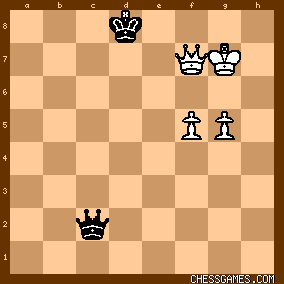
click for larger view
There's not a shadow of a defense here, the white pawns march on. |
|
Sep-13-09
 | | Peligroso Patzer: <ChessYouGood: black should have resigned MUCH EARLIER *** > <JohnBoy: <ChessYouGood> - black should NOT have resigned earlier. White was having a hard time finishing the job, and black appropriately demanded a proper finish.> <furrer: I agree [with] John Boy, and don’t we all remember an endgame very much the same as this one?Topalov vs Anand, 2005 > <JohnBoy> is absolutely right. Queen endgames are very, very tricky and almost always worth playing out. In the game cited by <furrer>, which ultimately was drawn in 97 moves, both of the elite players involved went astray. Specifically, the position after 73. … Qxg5+: 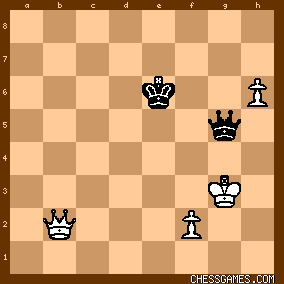
click for larger view is theoretically drawn, but Anand soon went wrong with 76. … Qg5+?. (The only drawing move here was 76. … Qh3+.) The position at this point became a theoretical win and remained so until Topalov erred with 90. h7? (when either 90. Qh5+ or 90. Qg4 were the only theoretically winning moves). From that point to the end, the game was a theoretical draw. Thus, in the game cited by <furrer>, which was played at a regular time control in the 2005 World Championship tournament, the two players currently [i.e., as of September 2009] rated #1 and #2 in the world each committed a half-point blunder in the ending; and, just to illustrate how tricky these endings can be, although such a blunder from any elite player would be extremely unlikely, at either move 94 or 96, if Toplaov had tried to avoid a repetition by playing 94. Kh6?? [or 96. Kh6??], Anand would have won on-the-spot by checking on the 6th rank. BTW, here is another Queen ending in which the current [September 2009] #1 rated player gave away half a point: Morozevich vs Topalov, 2007. (See comments in the thread on the linked page.) |
|
Sep-13-09
 | | maxi: Absolutely. One should NOT resign this type of ending. As a matter of fact there are many games on record where the weak side draws... and sometimes wins! They are tricky and dangerous, and accident prone. Either side can easily get mated at any moment. They are also very tiring which makes them even more dangerous. |
|
Sep-13-09
 | | Peligroso Patzer: With regard to how difficult Queen endings can be, there is an interesting discussion of Q + 2p vs. Q endings in “Secrets of Practical Chess (New Enlarged Edition)”, by John Nunn, Gambit Publications ©2007 at pages 247-249. This discussion occurs in the context of a review of Reuben Fine’s classic “Basic Chess Endings”, including the revised edition edited by Pal Benko. Among the most interesting of Nunn’s comments is the observation that, contrary to the opinion of Fine and other world-class players of his era, modern tablebases reveal that <“the ending of Q +aP+bP vs. Q is generally drawn”> (ibid. at page 248). (The same would, of course apply to endings in which the two pawns were on the g- and h-files.) In T Karatekin vs P Hummel, 2003, the pawns were on the f- and g-files, and the position after 47. … Qxh6: 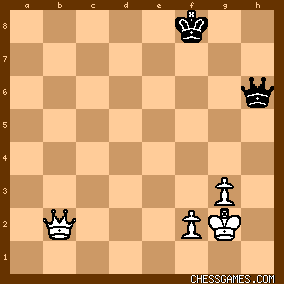
click for larger view is a theoretical win. There were several points after that where White either missed the fastest win or actually allowed the position to become a theoretical draw. For example, 68. Kf6? threw away half-a-point (it was the “only drawing move”; in the position after 67. … Qc2, any other move that did not hang the White Queen was a theoretical win). Black quickly went wrong, however, with 69. … Qc3+ (when 69. … Qc7 was the only drawing move). A couple of dozen moves later, 93. Kf6? was again an “only” drawing move. Unfortunately for Black, he went wrong with 96. … Qb4+ (instead of 96. … Kg7!, a good “only drawing move”). In reply, White failed to find 97. Ke3! (only winning move), but after 98. Kc4, Black did not find any of three drawing moves (98. ... Qc8+ or 98. ... Qe4+ or 98. ... Kg7), and after 98. … Qc6+?, the position was winning for White and remained so to the end of the game (even though White did not always play the fastest winning move). It should finally be noted, however, that as late as move 108, in this position: 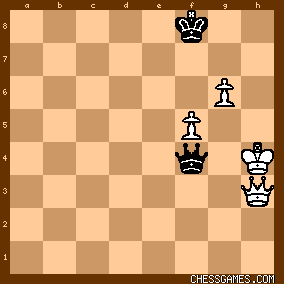
click for larger view the plausible 108. Qg4 would have allowed a draw with 108. … Qf2+ (among other moves). After 108. Kh5!, Black’s next two moves hastened his loss by walking into a forced mate on the light squares. So, in conclusion, the comment somewhere in this thread that Black should have resigned “MUCH EARLIER” is completely off-base and reflects a lack of appreciation of the difficulty of Queen endings. |
|
Sep-13-09
 | | Peligroso Patzer: <al wazir: Wouldn't 58. Kg6 have been a surer and faster (much faster) way to win? If 58...Qc2+, then 59. f5 Qc7 (forced) 60. Qe6+ Kh8 (<60...Kf8 61. f6> Qc2+ 62. Qf5) 61. f6 Qh7+ 62. Kg5 wins.> Although 58. Kg6 is a winning continuation, it is not as fast as your analysis suggests. In the variation with 58...Qc2+ 59. f5 Qc7 60. Qe6+ Kf8, <61. f6?> is a blunder [the most accurate move here is actually 61. Qf6+, which wins in 25 moves). After 61. f6?, the stalemate theme allows Black to draw with 61. ... Qh7+!=. |
|
| Sep-13-09 | | bengalcat47: For those who would like to study Queen endings in more detail I suggest Yuri Averbakh's book "Queen and Pawn Endings." It's written in the older style, descriptive notation, but the book is well worth
it for its extensive coverage of these difficult endgames. |
|
| Sep-13-09 | | pferd: White has an easy win (thanks to endgame data base) at move 48: 48.Qb4+ angling to exchange queens by checking (or pinning) from f4 or h4. e.g. 48.Qb4+ Ke8 49.Qa4+ and fork King and Queen next move. |
|
Sep-13-09
 | | al wazir: <Peligroso Patzer: Although 58. Kg6 is a winning continuation, it is not as fast as your analysis suggests.> I agree. After I posted I found <58. Kg6 Qc2+ 59. f5 Qc7 60. Qe6+ Kh8 61. f6 Qh7+ 62. Kg5> Qg6+!, and white cannot take the ♕ because of stalemate. (There are other stalemate threats in alternate lines as well.) White wins by maneuvering his ♔ to the eighth rank. Eventually black has to check along the rank; white interposes his ♕; and after the next check the white ♔ moves off the rank, discovering check. |
|
| Sep-13-09 | | JohnBoy: I like <sfm>'s 64.Kg6 as an immediate win. Even quicker than 65.f5 (after ...Qb1+) is the simple 65.Qf5+ and off come the queens. |
|
| Sep-13-09 | | JohnBoy: While <pferd> points out a nice finish at move 48, I wonder if white could have done the job with 47.h7. It looks like black's only reasonable reply is 47...Qg7. Is there a cute finish here? |
|
| Sep-13-09 | | DarthStapler: Interesting endgame |
|
| Sep-13-09 | | whiteshark: <32...Qb2> looks better, at least it prevents white from playing 33.e6. |
|
| Sep-13-09 | | sfm: <JohnBoy: sfm's 64.Kg6 ... Even quicker than 65.f5 (after ...Qb1+) is the simple 65.Qf5+ and off come the queens.> Eh, I just wanted to check if anyone paid attention... ;-) |
|
| Sep-13-09 | | sfm: <pferd: White has an easy win .. 48.Qb4+>
How elegant! Would have cut the scoresheet in half.
- - -
<JohnBoy: 47.h7. It looks like black's only reasonable reply is 47...Qg7. Is there a cute finish here?>
Looked at that too, but dropped it. Whenever White takes a queen on h8 Black graps it, then gets his own on b1 |
|
| Sep-13-09 | | RandomVisitor: Position after the suggested improvement 46.Qa8+!
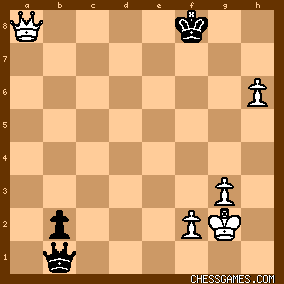
click for larger viewIf 46...Ke7 47.Qb7+ followed by h7
If 46...Kf7 47.Qb7+ followed by h7
The white Queen now covers the h7 pawn, the black queening square on b1, and the 'harassment check' square e4. Black cannot stop the white pawn from queening, or do anything at all. |
|
| Sep-13-09 | | sfm: <RandomVisitor: Position after the suggested improvement 46.Qa8+!> OMG! One more easy win. |
|
| Sep-13-09 | | chillowack: <ChessYouGood: black should have resigned MUCH EARLIER ->
As Ponomariov once said: "It's never too late to resign." |
|
| Sep-13-09 | | WhiteRook48: white's walking on air |
|
| Sep-13-09 | | smitten: I just wonder: who was in MIT and who in Caltech? |
|
| Sep-13-09 | | tamerkaratekin: Hello all : - ) I must thank the site admins to put my game up here : - ) I never thought playing a queen endgame with two pawns up would be so difficult to win... Pferd, RandomVisitor, and Peligroso Patzer, your analysis are all correct. I don't want to blame the time trouble, since it existed both for me and my opponent, but I don't remember myself practicing 3-4 move forced wins in queen endgames ever. Usually, players put great amount of training to solving complex combination quizzes, but when it comes to put similar training to increase endgame technique, many are lazy, including myself : - ) So I missed 48.Qb4 and 46.Qa8+!... Rest was really long... I knew it had to be a theoretical draw when my king started to walk around the middle of the board, but somehow it managed to turn back to the edge of the board and hide. That queen ending chapter in Nunn's book is great and very practical, I hadn't read that book at the time of the game. Averbakh's book is also a classic. Nunn advocates doing training matches against your chess software in different endgame situations where you are material up. I think such kind of training should be in every chess player's repertoire. |
|
| Sep-13-09 | | RandomVisitor: <tamerkaratekin>Thanks for your insight. |
|
Sep-13-09
 | | tpstar: <tamerkaratekin> Welcome to the site! =) Click on your name here Tamer Karatekin or up top to reach your player page. You could upload more of your games for this site, or even add annotations and/or kibitzing comments to your database games. |
|
| Sep-14-09 | | tamerkaratekin: Hi tpstar : - )
I uploaded a bunch of new games recently, and some of them included minor notation mistakes so I had to get in touch with the site admins for corrections, and then, Daniel was kind enough to make one my games as the "game of the day" : -) I suggest you to checkout my simul games against Kasparov and Karpov. I managed to get a full point from these two world champions, and no, I wasn't playing Kasparov's moves with white against Karpov with black, and vice-versa... Both games are pretty interesting, I'll update some analysis later on... In summary, in both games, I managed to hold on after disadvantageous openings. Kasparov simul game
Kasparov vs T Karatekin, 1997
Karpov simul game
Karpov vs T Karatekin, 1997
Smitten, Patrick Hummel was a first or 2nd year student at Caltech at the time of the game. Judging from the quality of analysis and jokes :-), this forum is pretty good. Take care : - ) |
|
| Sep-15-09 | | chillowack: I played through your simuls vs. Kasparov and Karpov...well done! It must be very difficult to get draws against these legends, even in simuls. |
|
| Nov-20-09 | | tamerkaratekin: :-) I was watching the 2009 world blitz championship games. A particular game resembles my game against Hummel a lot. http://chessgames.com/perl/chessgam... Carlsen is the highest rated player in the world during that game. Gashimov is also among top 10 I believe. He was also one of the highest rated blitz players on ICC. And their blitz encounter results in a queen endgame. White is a pawn up, 3 pawns vs 3 pawns on king side, white has the c pawn extra. Well, white could not force win under time trouble. Instead, he attempted a similar king march, the one I attempted against Hummel, and it led to a forced perpetual check. After 67. c7??, Black has perpetual check, and it should be draw. (Carlsen must have lost on time) Instead, 67.Qb6 wins. This was a blitz game, I am sure under regular timing controls such mistake would not happen, but it shows the automatic response of a top GM. Just walking the pawn forward with queen support is not enough to win. Somehow, the queen must also take part in the defense of the perpetual check threat, while still helping the pawn advance. End game technique is very automatic, you make a move mostly based on your end-game instincts, and under current timing controls, when the endgame stage is reached, usually not much time is left to calculate as well. So, I don't think even the very best practice queen endgame technique that much. I had asked my Ukrainian teammate in Turkish league Moiseenko (ranked top 50 in the world), and he also admitted queen endgames being difficult even at their level, showing a few of his own games. I am sure there are GMs out there who studied queen endgames in and out, but for the most players, queen endgame technique is lower on their to-train list. I am sure tough with several weeks of focused training you can be a queen endgame pro. :-) Encyclopaedia of chess endings "Queen" edition is a good place to start. |
|
 |
|
< Earlier Kibitzing · PAGE 2 OF 2 ·
Later Kibitzing> |
|
|
|





